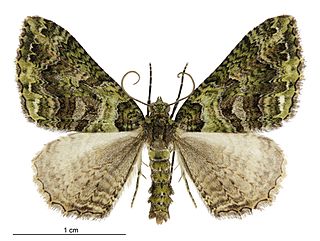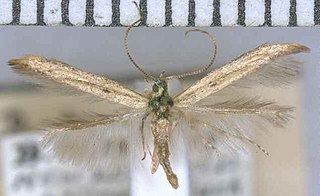
The insect order Neuroptera, or net-winged insects, includes the lacewings, mantidflies, antlions, and their relatives. The order consists of some 6,000 species. Neuroptera is grouped together with the Megaloptera and Raphidioptera (snakeflies) in the unranked taxon Neuropterida.

The antlions are a group of about 2,000 species of insect in the neuropteran family Myrmeleontidae. They are known for the predatory habits of their larvae, which mostly dig pits to trap passing ants or other prey. In North America, the larvae are sometimes referred to as doodlebugs because of the marks they leave in the sand. The adult insects are less well known due to their relatively short lifespans in comparison with the larvae. Adults, sometimes known as antlion lacewings, mostly fly at dusk or just after dark and may be mistakenly identified as dragonflies or damselflies.

Francis Walker was an English entomologist. He was born in Southgate, London, on 31 July 1809 and died at Wanstead, England on 5 October 1874. He was one of the most prolific authors in entomology, and stirred controversy during his later life as his publications resulted in a huge number of junior synonyms. However, his assiduous work on the collections of the British Museum had great significance.

Ascalaphidae is a family of insects in the order Neuroptera, commonly called owlflies; there are some 450 extant species. They are fast-flying crepuscular or diurnal predators of other flying insects, and have large bulging eyes and strongly knobbed antennae. The larvae are ambush predators; some of them make use of self-decoration camouflage.

Hemerobiidae is a family of Neuropteran insects commonly known as brown lacewings, comprising about 500 species in 28 genera. Most are yellow to dark brown, but some species are green. They are small; most have forewings 4–10 mm long. These insects differ from the somewhat similar Chrysopidae not only by the usual coloring but also by the wing venation: hemerobiids differ from chrysopids in having numerous long veins and forked costal cross veins. Some genera are widespread, but most are restricted to a single biogeographical realm. Some species have reduced wings to the degree that they are flightless. Imagines (adults) of subfamily Drepanepteryginae mimic dead leaves. Hemerobiid larvae are usually less hairy than chrysopid larvae.

Austrocidaria similata is a species of moth of the family Geometridae. It endemic to New Zealand.

Batrachedra arenosella, the armoured scale eating caterpillar or the coconut moth, is a species of moth of the family Batrachedridae. It was first described by Francis Walker using specimens collected in Auckland, New Zealand. It has been hypothesised that the New Zealand moth may contain two distinct species. As well as the moth species in New Zealand, this name has been applied, perhaps incorrectly, to moths found in India, Indonesia, the Malay Peninsula, and Réunion, as well as in Australia, from the Northern Territory and northern Queensland to New South Wales and South Australia.

Eudonia submarginalis is a species of moth in the family Crambidae. It was described by Francis Walker in 1863. It is endemic to New Zealand.

Pasiphila bilineolata is a moth in the family Geometridae. It is endemic to New Zealand and can be found in the North and South Islands. The species inhabits native forest and shrubland and the larvae feed on Hebe species. Adults are on the wing commonly from August to January but have been observed most months of the year and are attracted to light.

Ascalaphus sinister is a species of owlfly from northern India. The thorax is covered in brown hairs, with yellow markings on the sides and ventral surface and a yellow stripe running down the dorsum. The head is yellow and covered in white hairs, with some black hair on the vertex. The antennae are rust red and not as long as the wings. The elongate abdomen is saffron yellow with two black stripes down the back and a number of black streaks along the sides. Legs are yellow. The vagina in females is short and wide. The bursa copulatrix and receptaculum seminis are relatively proximate, with the latter being sclerotized and wrinkled.

Eudonia sabulosella is a species of moth in the family Crambidae. This species is endemic to New Zealand and is regarded as being common. The larvae of this species are known to damage pasture in New Zealand.
Cordulecerus is a genus of owlflies, neuropteran insects in the subfamily Ascalaphinae. Species are found in Central and South America.

Proteuxoa comma is a species of moth in the family Noctuidae. It is endemic to New Zealand. It can be found in the lower half of the North Island and throughout the South Island, although it appears to be more frequent on the eastern side of these islands, and also is present in Stewart Island. P. comma is very similar in appearance to P. tetronycha but can be distinguished as it is a larger moth with slightly different colouration on, as well as shape of, its forewings. This species pupates in the soil. The adult moths are on the wing from December to April. P. comma may possibly be declining in population and as at 2017 a reassessment of its conservation status is regarded as being needed.

Carystoterpa fingens, commonly known as the variegated spittlebug, is a spittlebug of the family Aphrophoridae. It is endemic to New Zealand.

Glenurus is a genus of antlions in the family Myrmeleontidae and typical of the tribe Glenurini. There are about 12 described species in Glenurus.

Mallada basalis is a species of green lacewing in the family Chrysopidae, first described by Francis Walker in 1853. No subspecies are listed in the Catalog of Life. The species was detected on mainland New Zealand in the 2010s.

Ichneutica disjungens is a moth of the family Noctuidae. This species is endemic to New Zealand and can be found on the central volcanic plateau of the North Island and in the eastern as well as the south western parts of the South Island. I. disjungens inhabits tussock grasslands in the alpine and subalpine zones. The hosts of the larvae of this species include Poa cita, P. colensoi, and Festuca novae-zelandiae. The adults of this species are distinctive and are unlikely to be confused with other species. They are on the wing between October and March.

Heoclisis is a genus of cave-dwelling antlions, that is, insects in the family Myrmeleontidae.

Stenoperla prasina is a species of stonefly belonging to the family Eustheniidae. This species is endemic to New Zealand and is classified as "Not Threatened" under the New Zealand Threat Classification System. It is found on the North, South and Stewart Island / Rakiura Islands as well as on Little Barrier Island. Although adults of this species are most often coloured bright green, this species can be coloured yellow. This species inhabits clean, cold, running streams and rivers with stony bottoms within native bush. It is a known indicator of water quality. The larvae eat plant detritus and other aquatic insects while the adult insects feed on sooty mould fungi as well as other plant matter. The adults of this species are a known food source for New Zealand long tailed bats. Adults have been dissected and have been found to have been carrying Nematomorpha and trematode parasites. The New Zealand Department of Conservation classifies this species as "Not Threatened". In 2022 a specimen of this species was the 5 millionth specimen to be digitised in the Natural History Museum, London collection.
Douglas Eric Kimmins was a British entomologist.


















